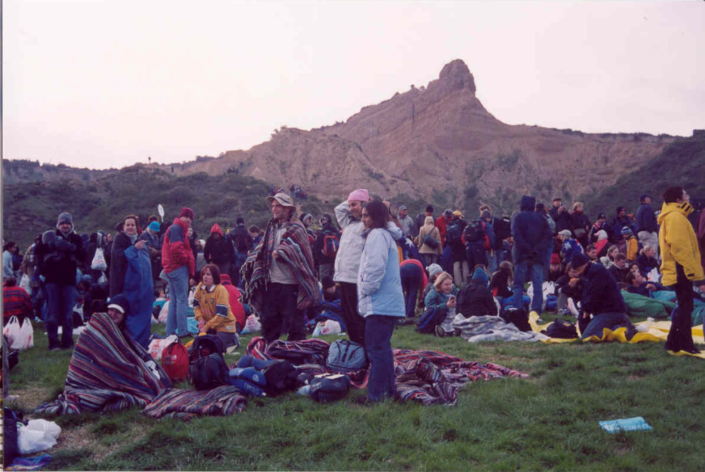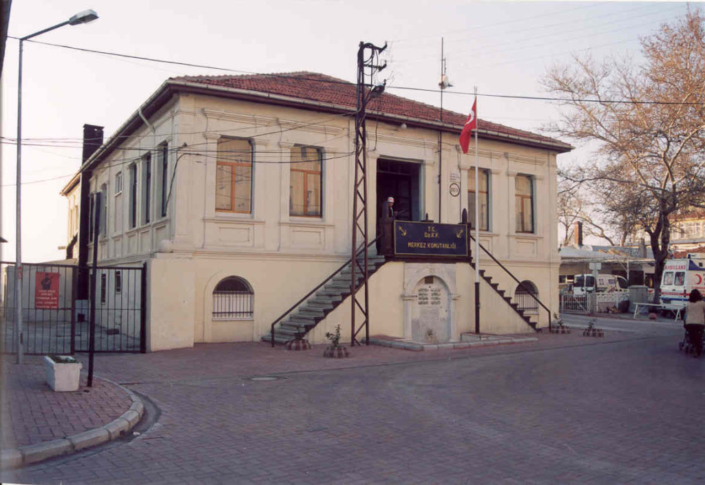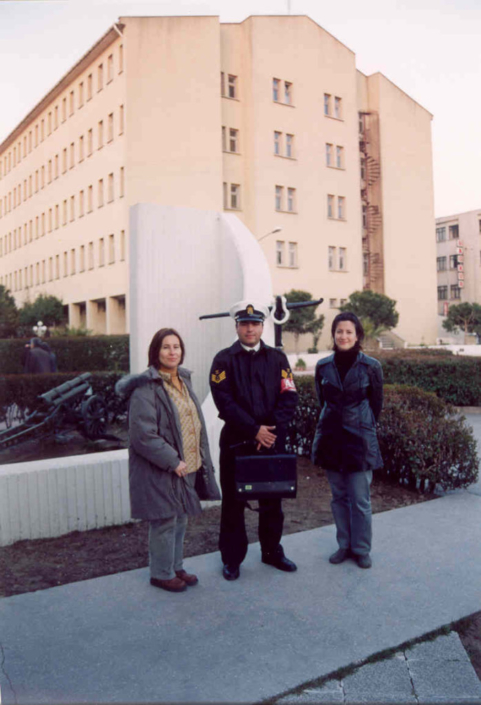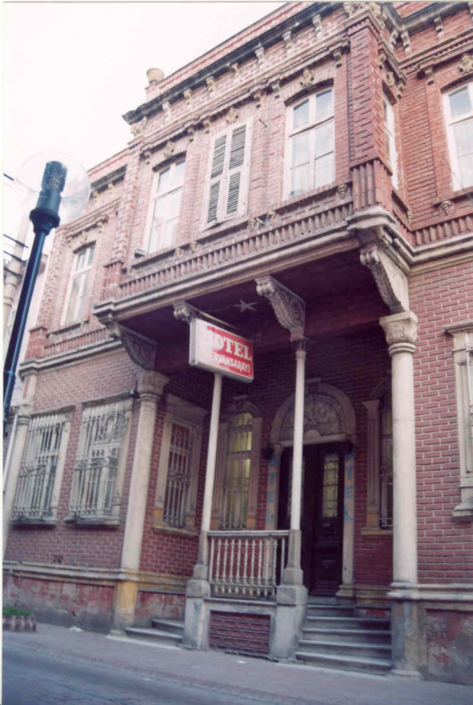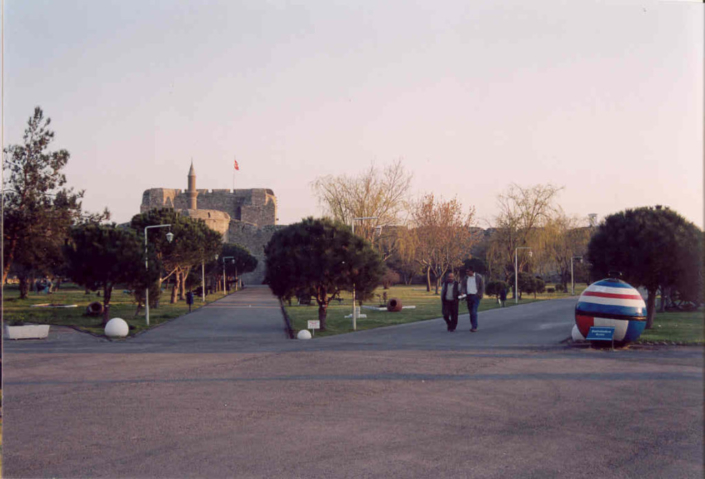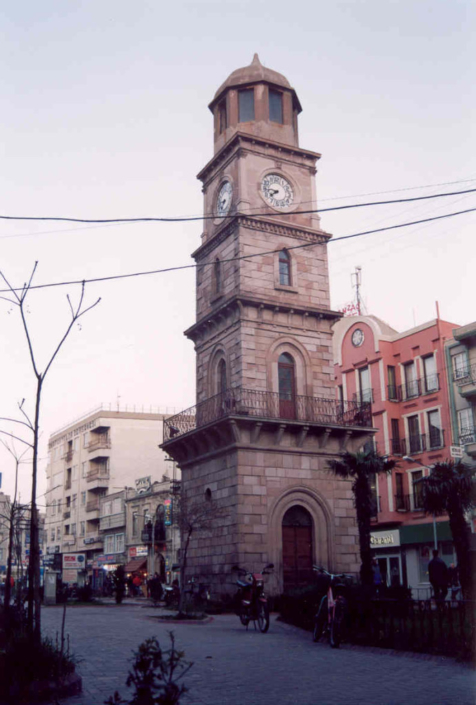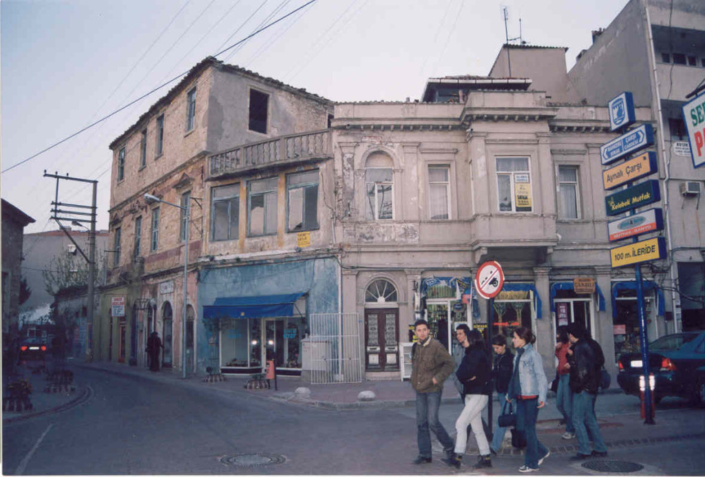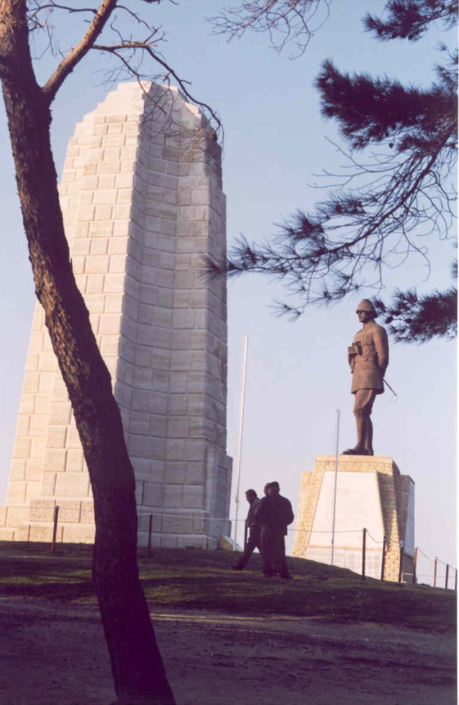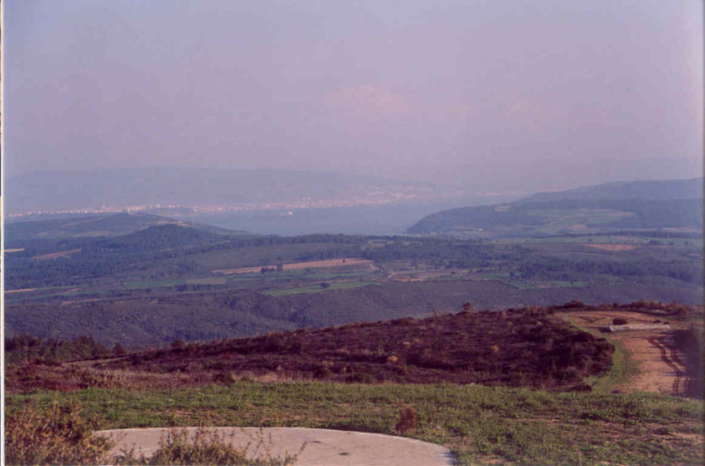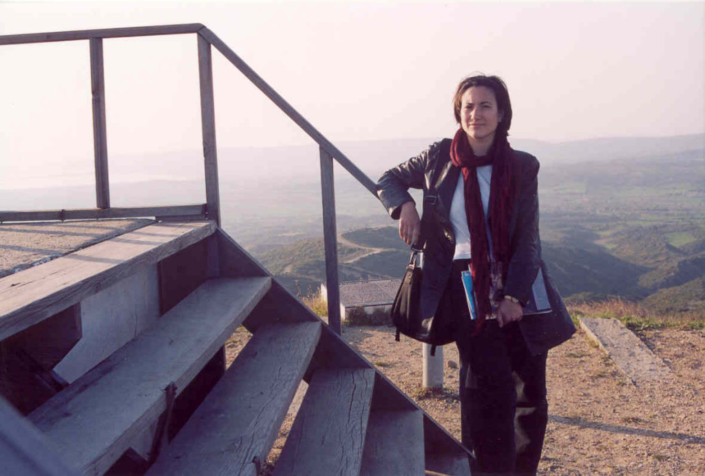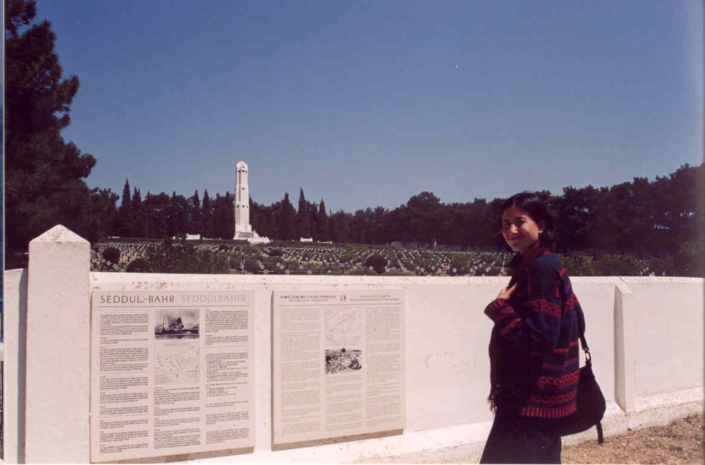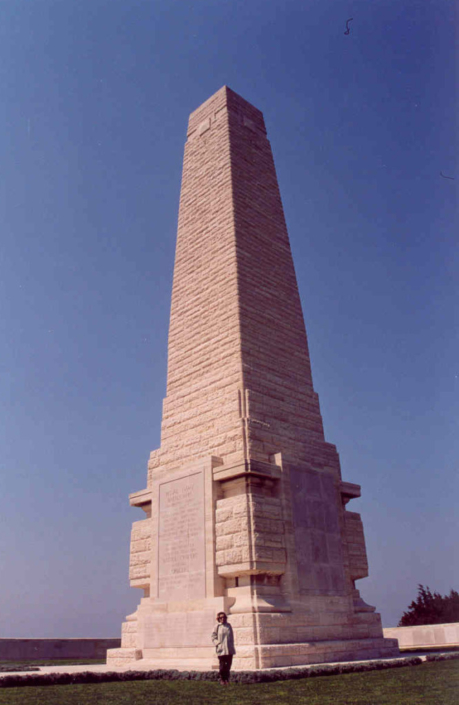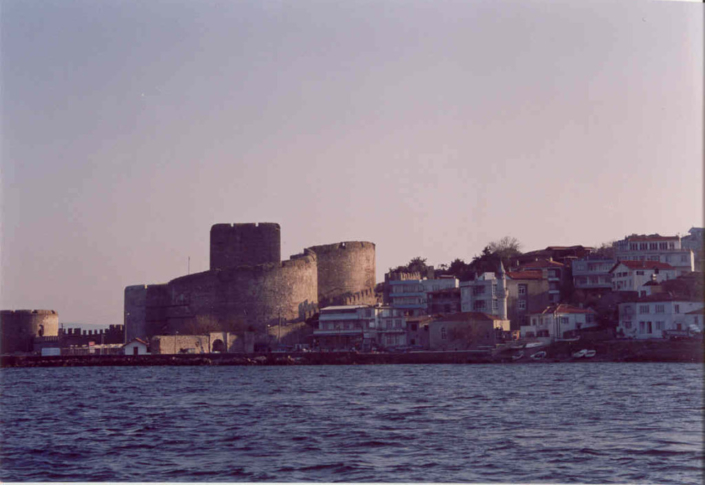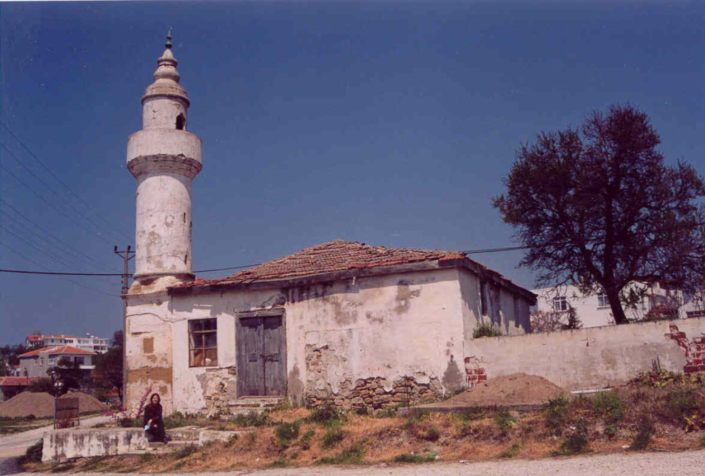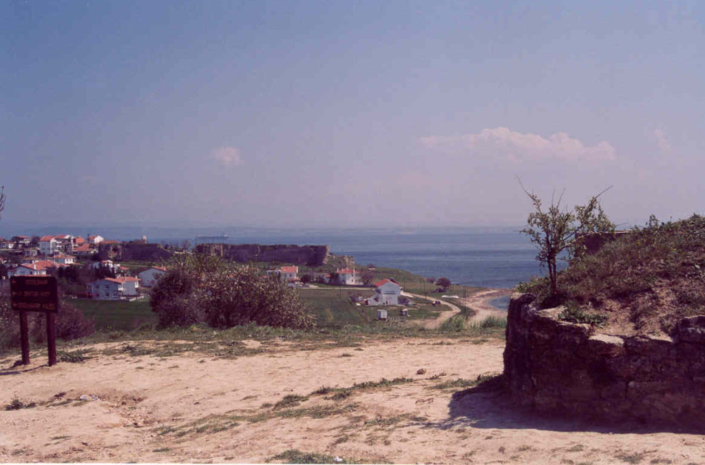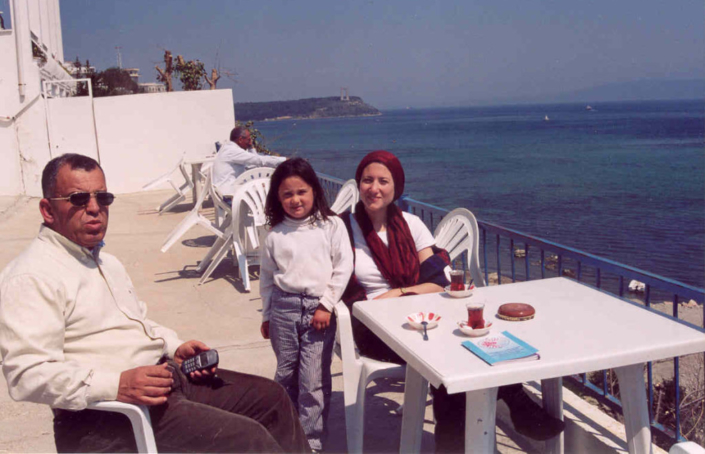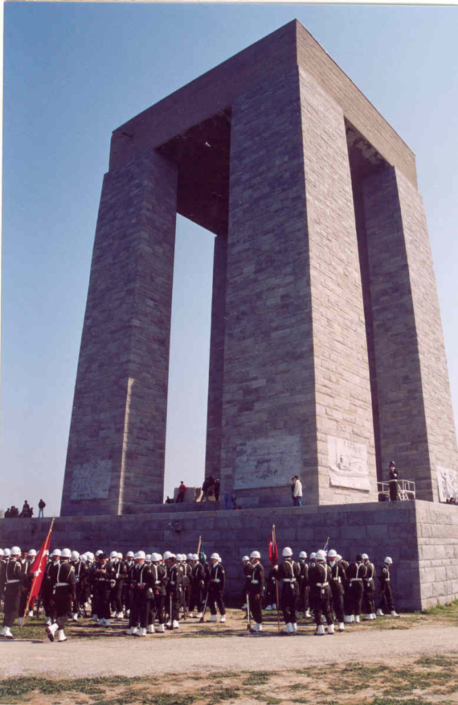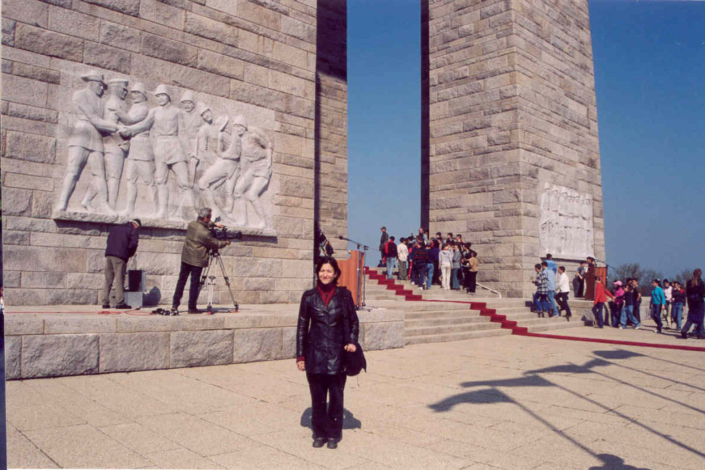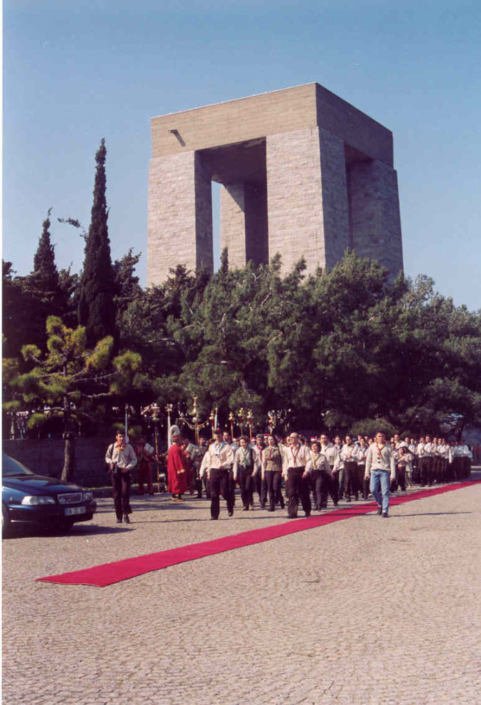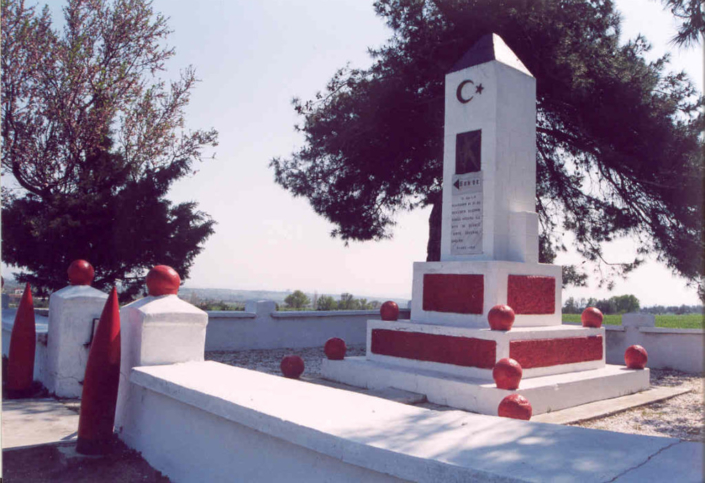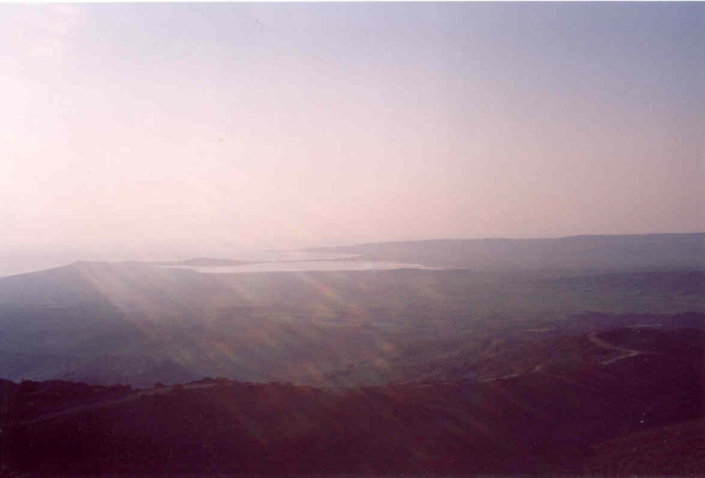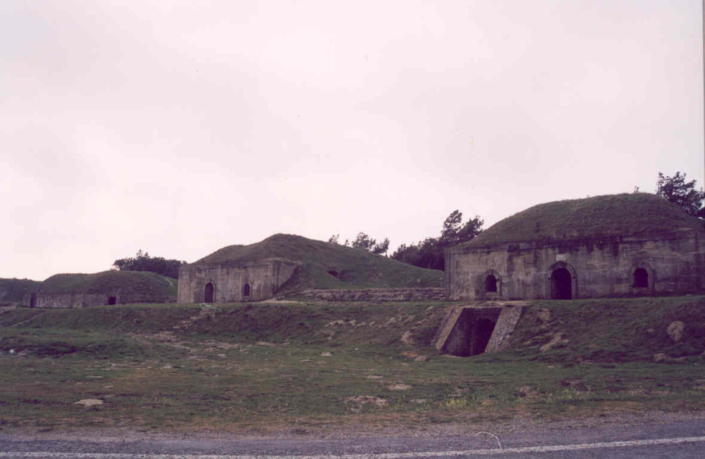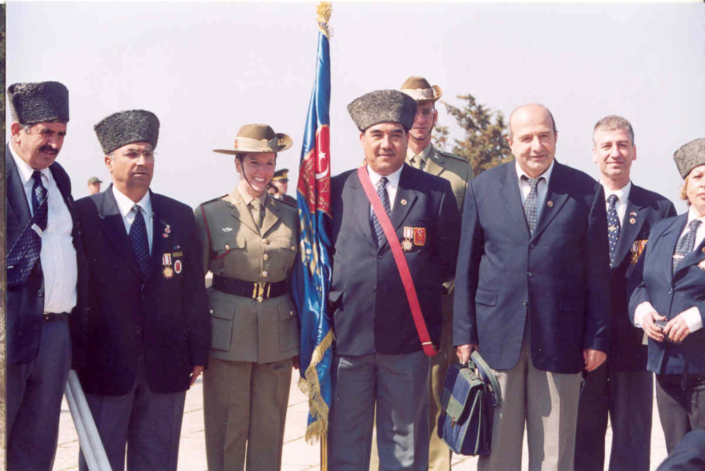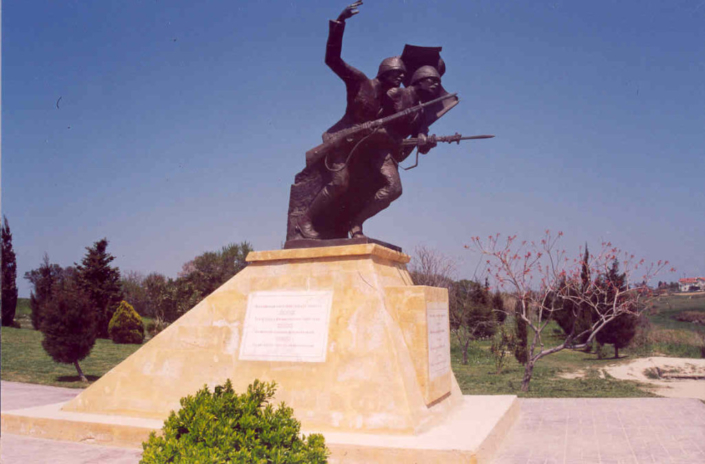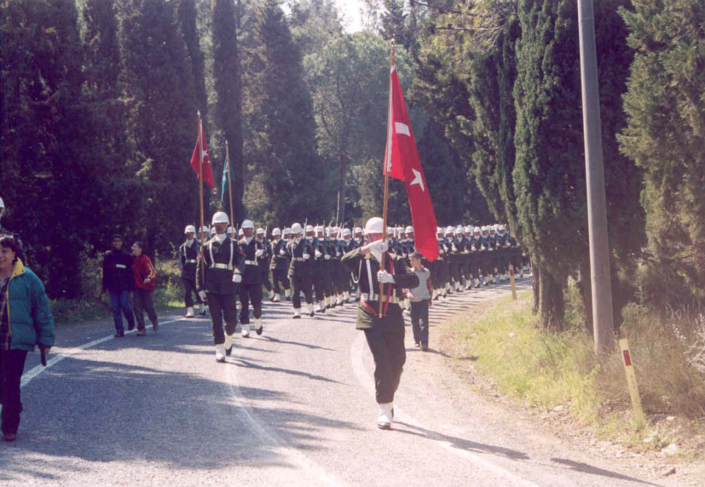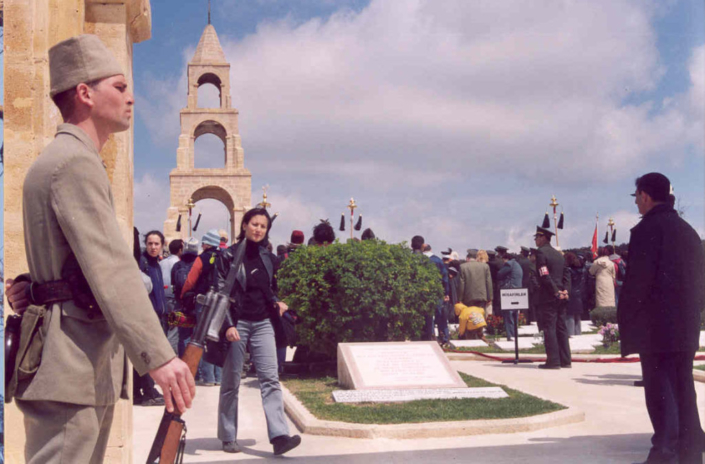GALLIPOLI JOURNAL- 2003
‘Prologue’:
Last year, some things that happened to me one after the other affected me in such a way that I promised myself, many months in advance, to “go to commemorate Gallipolu next year”.
It was a sad ve trying week, in which our cat Sümbül was fatally poisoned and my sister had an emergency appendicitis operation. In those same days, I was volunteering in a workshop presentation organized by the Chamber of City Planners on the occasion of visiting Australian colleagues. As I was translating the words spoken by Australian Ambassador Mr. Jonathan Philp, one point caught my attention, perhaps for the first time for me:
Australia and Turkey had something in common: they had both acquired their identity and consciousness of nationhood through the same historical event.
When Emine was discharged from the hospital and came home, she put on a videotape of Mel Gibson’s film, Gallipoli. As we started watching together as a family and commenting on the film, the topic of Buket Uzuner’s book, ‘Gelibolu – Uzun Beyaz Bulut’ (‘Gallipoli- Long White Cloud’) came up. Down, too, came the book from the shelf, and I started reading it that evening. With my already sad and sensitive emotional state, the story made a deep impression in me… One week later, our office attended a cocktail at the Swiss Embassy, where I ran into an Australian diplomat. His recounting, during our brief chat, of the visit to Gallipoli that he made every year as a sory of pilgrimage, must have really hit the nail on the head, as I had a strong revelation that “my never having gone there till now was a disgrace and it was a duty for every citizen to do it”. It is ironic that one has such revelations usually when one is in contact with foreigners …
Let me try to give the uninititated with some basic facts, which I myself learned during this personal project: During the First World War, the Allied Forces sought to gain access to the straits of the Bosphorus and Çanakkale in order to send reinforcements to the Russian front, and on March 18, 1915, under British General Ian Hamilton’s command, they launched the largest naval attack in history at that time. However, this attack was heavily repelled by the defense of the Turkish forces stationed on both sides of the Çanakkale Strait, and especially by the surprise mines laid by naval ship Nusret, which resulted in the sinking of three Allied battleships. The March 18 Victory is celebrated by the Turks with official ceremonies every year. As for April 25 1915, this is the first day of landing on the southern and western shores of the Gallipoli Peninsula by the Allied armies, who decided to try a land attack upon the failure of the maritime attempt. This was also the first day of a tough war that would last for months, where the Allied forces, despite being far better equipped logistically, would be held up by a highly motivated and well-organized (Mustafa Kemal…) Turkish defense and finally retreat. This date is remembered both by the Turkish and other nations (i.e. mainly the Australia and New Zealand Army Corps- ANZACs for short- and to a degree by the British and French).
With the information I gathered about the March 18 and April 25 commemoration events and a suitable opening in my schedule gave way to a trip around April 25. After tentative plans made with various friends but ultimately cancelled, my mother Madame Şahika agreed to come with me. It was easy to convince her once I managed to awaken her appetite for traveling- sightseeing- adventure, something that was found in abundance in her and which she had transmitted to me in the first place (during a genetic event). And so began the following chronology of events:
23 April, Wednesday evening:
The bus journey toward Çanakkale that began at AŞTİ (Ankara Inter-City Bus Terminal) with Truva Travels.
Misinformation about the arrival time of the 22.30 service (they had told us that it would arrive early in the morning, but it turned out that it was the 20.00 bus that would arrive at 06.30. Will we manage to make it to the ceremony on time?..)
24 April Thursday, morning:
Meeting at Çanakkale bus terminal with Mr. Macit of Oto Miller, to pick up the Fiat Pallio.
A short tour around the Military Museum and Çimenlik Castle (Kale-yi Sultaniye) before boarding the ferry together.
Passage to Kilitbahir by ferry and parting with Mr. Macit.
My mother is driving the car.
We are heading south, passing by Kilitbahir Castle (through the arched gate in the wall, by the bastions).
Sultan Mehmet the Conqueror had the Kilitbahir Castle, situated on the European or Peninsula side, built along with the Kale-yi Sultaniye on the Asian side, shortly after the 1453 conquest of Istanbul. Shaped like a heart, Kilitbahir = kilid-ül bahir (‘lock of the sea’) – love these Ottoman etymology games… – lies at the narrowest point of the Çanakkale Strait, indeed holding the heart of the matter of crossing the strait.
Arrival at the residence of Güven & Vicdan Nil at Soğanlıdere. Introduction with Ms. Handan (Mr. Güven’s niece), her husband Mr. Alpaslan and little Kaan.
The late Mr. Güven Nil, my father’s friend from high school, cultivated a vineyard here. I seem to recall that this must be the region where they make the Serafin wines, which was presented to Clinton when he visited Turkey. In the reading material on Gallipoli, I saw a ‘Serafim Ranch’ marked in this vicinity on some maps… So the origins of that wine must be somewhere on this peninsula… By the way, the opportunity to stay in this beautiful vineyard house, while all hotels are packed over in Çanakkale, was an important advantage of traveling with Madame Şahika… The Gallipoli Peninsula and the city of Çanakkale hosts a huge amount (‘army’?..) of Anzac visitors, even if just for a few days of the year– the grandchildren of the Anzac soldiers who landed on our shores on these dates in 1915, still continue the tradition, but in a very different format, of course!!.. The transformation of this hostile landing into a peaceful one, as cliché as it may sound, is truly an impressive event that has lessons for us to draw from. I had plenty of opportunity to stop and think about it… – In the secretariat office of the Gallipoli Peace Park Competition, Burak, one of my friends from the (METU City Planning) Department who was working there with our professor Raci Bademli, told me that the tourism infrastructure in the region is nowhere near the capacity to handle this load. As the Competition bureau, they were assigned to designate the camping zones where ‘tent-hotels’ would be set up, in cooperation with the Turkish Land Forces.
According to the Commemoration Ceremonies program faxed by Mrs. Minnow, mother of my dear friend Deniz (‘iziz’ of gezgin.com) who works at the Australian Embassy, the ceremonies started at 09.00 am in the ‘Şehitler Abidesi’ (Martyrs’ Memorial). After getting ready for the day, we arrived there shortly before 10 am. The dignitaries were moving from the area in front of the Memorial where speeches were made toward the museum. We hung around a little bit, and then entered the museum after them. In the museum, diagrams, maps, documents and many objects remaining from the war were on display. We then spent a few hours in the ceremony area, among the parading scouts, fur capped children of veterans having photographs taken together, uniformed ANZAC soldiers, Turkish soldiers, privates, commanders, children, ANZAC tourists, and a ‘mehter’ (Ottoman military band) show.
As we would find an opportunity to do so several times during our trip, we chatted with some army officers on duty, primarily to find out the ropes of navigating ourselves here. As per their advice, we waited a while before going to the French and British monuments. We sat down on some rocks overlooking the sea and had our homemade sandwiches.
The Gallipoli Campaign took a toll of 280,000 killed, injured or missing in action, with our 250,000 and the Allies’ 280,000 casualties, composed of 200,000 British, 40,000 French, 20,000 Australians, 4-5,000 N.Zealanders, as well Canadian, Indian and soldiers of the French coloines of North Africa. It is a bewildering fact that the Gallipoli Peninsula, as a narrow piece of land that still contains thousands of corpses without known graves, is one of the world’s densest war burial sites.
Afternoon:
On our way to the French Memorial, we stopped at a roadside fountain, washed our faces to feel refreshed, then found the monument and parked the car. It was unbelievably quiet. We involuntarily disturbed some gendarmerie guys napping under a tree. Then we saw a three-person group with a rental car whom we thought to be French. They were sympathetic types with whom we later encountered again on the road and made a greeting gesture by giving them the way.
Our next stop was the First Martyrs Memorial (İlk Şehitler Anıtı) at Seddülbahir.
(Before the April 25 landing or even the March 18 naval battle, the British Navy bombarded this area at the southern tip of the peninsula in retaliation to the German ships that dragged the Ottomans into the war with the cannons they fired on to the shores of Crimea; this memorial was put up in honor of the 5 officers and 81 privates that were killed here.)
This is a modest memorial, but the concise information conveyed by the text engraved on it succeeded in moving me… I believe the Turkish army’s defense at Gallipoli was just that: Modest but potent…
After using the restroom at the café next to the memorial, we came across a curious gentleman standing next to his Istanbul-license-plated car at the carpark: Mr. Bülent, the wandering soul who knew this area well, invited us to tea at Konak Café overlooking the small fishermen’s bay of Seddülbahir (sed – ül – bahir = this means the wall of the sea, nice, huh?) (I guess Mrs. Şahika’s charm was at work once again!!), where a pretty young girl served us the tea. We got some information from Mr. Bülent about the Salim Mutlu Collection at Alçıtepe and the Zığındere martyrs. It is a blessing to receive local knowledge from people one meets along the way when traveling…
As we made our departure from Seddülbahir, on the road bound west, we stopped at the Yahya Çavuş (Sergeant Yahya) Memorial.
One really asks oneself if this was all true, but in this landscape laden with stories supernatural events, one gets the impression that some things are really possible, and listens accordingly: When the commanders of his squadron went down, Sergeant Yahya resisted a 2.000-strong British assault group with the remaining 67 privates; the British, thinking they were facing an entire division, reported as such to their headquarters. The significance of all this becomes clear when one learns the hierarchy of military units: Army – army corps – division (10.000 privates) – brigade – regiment – battalion – company – squadron (the smallest unit). This story was also immortalized in this poem written by Nail Memik (Gallipoli is a land of poetry …):
Bir kahraman takım ve de Yahya Çavuştular. (They were one heroic squadron and Sergeant Yahya)
Tam üç alayla burada gönülden vuruştular. (They wholeheartedly battled here with three regiments, no less)
Düşman tümen sanırdı bu şaheser erleri. (The enemy would think these magnificent privates a division)
Allah’ı arzu ettiler, akşama kavuştular. (They desired to meet their maker, and so they did that evening.)
There are a few trenches next to the monument, left as examples. A little further down, sales stands are selling tourist souvenirs, most of them produced with low skill levels. An ashtray with a pattern of skulls, invites a cold and lame joke by two Anzac tourist saying ‘it must be in memory of the dead!’ … There are also a few guidebooks, and we buy one. Tour buses have turned this area into quite a crowded place.
Walk to the (British) Helles Monument– A bus load of tourists (Anzac or British? Probably the latter) is having a group photo taken. Many Indian ‘Singh’s can be made out among the surnames etched in the stone walls around the monument. As one remembers the different nationalities that were embroiled in this war, one wonders how some of them must have experienced the feeling of being used for someone else’s war, as well as contemplating after reading how the Muslim and Senegalese enemies contributed to weaken the sense of religious brotherhood that had prevailed in the Ottomans. (Gallipoli, land of contemplation…)
The Alçıtepe – Salim Mutlu Collection, which we shortly after reached, is a home-made museum! It contains all kinds of knick knacks: dried frog and snakes hung on walls, a brand new Anzac hat, a rifle given as a present by the grandchild of an Anzac, many, many bullets, cartridge cases, flasks, boots, letters… many interesting souvenirs. It is amaterish, but vibrant. According to what Bülent Bey told us, our patriot uncle Mr. Salim Mutlu was the owner of a much more substantial collection before the 1980 military coup, but it was confiscated during the coup; the man started all over, collecting and creating this collection we see here …
Alçıtepe is an inland village (or maybe a town now) near the southern end of the peninsula. When the March 18 naval attack failed and the Allies decided to launch a land attack, the landing of April 25 was made in two main sectors, that of Seddülbahir and the other the Anzac sector on the western shores of the peninsula up north. If this attack in Seddülbahir had successfully advanced toward Alçıtepe, the Allies would have acquired a critcial advantage. Our ‘Mehmetçik’ (the symbolic name for a Turkish soldier) did not let this happen …
We then proceeded to see the monuments located along the way to Kabatepe. We decided to do this not through the road most travelled, but through the seaside route, winding along the west side. (Robert Frost: Two roads diverged in a wood, and I- I took the one less traveled by, And that has made all the difference.)
The sea on our left, with pine trees and grass around us… Are the tress sick? We noticed strange cone-like formations on the branches of some trees. I later read somewhere (if I could only remember where I read things…) that there was a mistake made with tree planting in Gallipoli, and pine should not have been planted… I wonder if this is true… The ‘Son Ok’ (‘Last Arrow’) Memorial.. the Nuri Yamut Memorial.. but the place I most felt the silence and heaviness of mourning was the Zığındere ‘Sargıyeri’ (‘Wound Dressing Place’) Cemetery.
In Zığındere Valley, a care facility was set up where the wounded from both sides were gathered. A bombardment by a British battleship completely destroyed this area that housed 40.000 patients, amounting to a huge massacre. This incident drew wide reactions also within the world press, but as an inscription on the monument reads, “it was too late”… Blind murder of war.
Kabatepe Visitor Center– A geometrically-shaped, slightly bulky and unusual building; it has nice landscaping around it, and a park in front that was designed through a national competition. Inside, one can visit a museum full of war remains, similar to the one in the Martyrs’ Memorial but more comprehensive. We obtained one of the maps prepared by the Gallipoli Peace Park Planning Office. In the meantime, we learned the story of Talat Göktepe, the Director of Forestry who was martyred in a large fire that occurred on the peninsula in 1994. There is a memorial for him as well, near Conkbayırı. We learned that if forestry officials are killed while defending the forests, they are also considered martyrs … Sacrificing of lives for Gallipoli did not end in 1915, we see; it still continues.
We set out again with the car, getting road information from Lieutenant Sedat. They have arranged the highway that connects the major points visited during the commemoration ceremonies as a one-way ring route. (But we did not really witness this route being strictly followed…) We set about following this ring, i.e. counter-clockwise on the map, first to the east (toward Eceabat), turning to Bigalı village, then from there to the northwest, to Anafartalar. (Anafartalar is the general name of two villages named Küçük (Small) Anafarta and Büyük (Big) Anafarta.) However, before reaching Anafartalar, we left the main road and turned to the left (westward) at the junction just before it, ascending to Conkbayırı.
From there, we took a shortcut to the southwest, bypassing the Salt Lake and the Anzac Cove, returning directly to the Kabatepe area. (I will not be surprised if you feel the need to pull out a map of your own after being faced with so many place names!…)
Bigalı Village – Atatürk’s House. The modest house in the village that Mustafa Kemal Atatürk used as headquarters has been nicely restored. The villager who took us into the house, sold us our entry tickets and took us on a tour inside is Mrs. Rebia Akgün, who lives in the house next door. Following the general pattern that had started to draw our attention by now, this pretty woman’s eyes were blue. My mother and I later discussed, with a wink, among ourselves, whether, beside being immigrants from the Balkans, the people around here might be the offspring of, some Anzacs who slipped in among the locals and contributed to their gene pool, just as Buket Uzuner had described in her book..!
In the Atatürk House, in the bedroom upstairs, we saw his exquisite silk pyjamas. There were more than one pair of these, including one from Yokohama! (The man knew how to dress well… And could he even keep it up at the battle front?..) At the Kabatepe Visitor Center, soldier uniforms of different nationalities were also on display. (Something caught my interest regardign this uniform issue while watching the ceremonies: The Anzacs were wearing the same uniform at Gallipoli that their grandfathers were wearing during the war, but the Turkish uniforms the Turks wore were completely– a brand new regime, a brand new state, I suppose a brand new uniform was inevitable.. I thought about it particulary when the next day, in the ceremony at the 57th Regiment Cemetery, I saw a young man enacting a ‘1915 Turkish private’ in historical costume.
Outside the Atatürk House, we had a sesion of chatting with the women sitting at the street side, taking photos and buying a couple of pieces from the souvenir sales stand, after which we had a look at the ruined house in the neighboring plot. A businessman from Istanbul apparently bought it, and asked the locals what he should do with it. The ones on the street showed it to me, when they learned I was working in an architectural practice. I found the ancillary building, which looked like a stable, very beautiful; it was in orderly shape, with branches lined along the tops of the courtyard wall, in a kind of ‘harpuşta’ (traditional Turkish walltop capping), as a valuable element of building heritage. I suggested they make a café and pension out of it, which is what they already thought about. We exchanged telephone numbers.
The villagers, who deal with agriculture, complained about how “the state neglect them”. (When they heard we were coming from Ankara, they said “Ankara does not hear our voice” and started to talk..)
These territories are under strict protective legislation. The peninsula is Historical National Park, parts of it designated as conservation areas. This restricts development, naturally. The protection is understandable and necessary, but the designating authorities should also realized they leave the villagers in a poor state of livelihood and propose solutions to this problem. The initiatives taken by Güven Nil and some other likeminded individuals to develop viticulture in the region, turned out to be appreciated by Mr. İsmail the Regional Director of Forestry, whom we later met, and who wished for more of these kind of efforts.
We made a short but brisk tour of Conkbayırı. Varios monument could be seen scattered over the soft curves of the uneven, forested terrain around Conkbayırı. The one standing out among these must be the Conkbayırı Atatürk Memorial. Next to it is another memorial, to the brother of Field Marshall Fevzi Çakmak. Not far from these, is the Mehmetçik Memorial. The watch platform at the highest hilltop of Conkbayırı is also open to visitation.
When we boarded that platform, we understood why Conkbayırı carries the title, which we could say became legendary within the Gallipoli battles, of being the most strategic and perhaps costliest to conquer. It provides a magnificent view that commands everywhere around the peninsula. In the hazy evening sun, we could not decide which direction to gaze in: to the Çanakkale Straits in the east, or in the direction of Anafartalar and toward Salt Lake, Suvla Cove and the Aegean Sea, in the northwest… In this high altitude, in a place where one cannot hear much else but the howl of the wind, it was again an appropriate moment to reflect, on the history that enables us to stand here so comfortably today. The only unfitting site within this environment was that of the strange policemen stationed nearby. They contributed another instance of interesting attitudes we encountered– I suppose, on one hand, they found us strange creatures who reason to be there was unclear, on the other, they seemed to ignore us ‘two sweet and harmless ladies’ …
We more or less skirted the Lone Pine Memorial, which is the main place of visit for Australians. For some reason, we ended up missing not one but two opportunities to visit this place, as we did not manage to make the ceremonies held there the next day, as a strange exception in our touring style of stopping by in every nook and cranny we could find! I guess it is an excuse to come back to Gallipoli, to complete the visit.
Evening:
As we were completing our First Day tour, we got into mobile phone contact with one of our gezgin.com members, Murat ‘Pegasus’ Ceylan, and agreed to meet at 19:00 in front of the Atatürk Memorial in Eceabat. My first impression of Murat, was that he was opinionated but helpful. (He was boasting about the plaque he received, along with two Anzac guys, from the Governor as the organizer of a Turkish–Anzac Friendship Walk that had started from Istanbul!) He is a field guide working for Fez Travel. By the end of our trip, I came to the conclusion that he was very warm and down-to-earth. Later, he protested against some unpleasant things that happened related to the Anzac Walk.
Our impressions from Eceabat mainly consisted of the large number of young Anzacs strolling about and dining in the restaurants along the waterfront where we walked after meeting Murat at the square, and the t-shirt industry that quickly burgeoned to cater to these youths. As for our dinner, it was unfortunately an unimpressive ‘home-made meal’ in a restaurant with fluorescent white lighting, next to the pide place Gül.
Return to the Nil residence around 21:00, some small chatting with Mrs. Handan and company, shedding the dirt of the day with a nice shower! Off to sleep at 23:00.
25 April, Friday, wee hours of morning:
At 03:00, we made a great leap forward out of our beds, with the feeling of being on a grand mission; we dressed up very quickly, got ready and left the house. I just wish I could leap like that on workday mornings!
We drove until Kabatepe. By now, we were used to being stopped along the road by the gendarmerie privates! I had never in my life disembarked and reembarked in a car, or interrogated by a soldier this frequently. But luckily it was not unpleasant, and actually quite interesting…
My mother and I had to walk the distance of 500 m to 1 km by ourselves. In the pitch dark, we watched the amazingly bright starts, just as I had in Nemrud Dagh in 2001… Thankfully this time no one sprained their ankle. Are we getting seasoned, or what?..
We came up to a checkpoint. Beside the sympathy that the patrolling soldier from Çorum, let us also mention the interest shown in my mother by Mr. İsmail, the Regional Director of Forestry that we met there! And the absolute lack of interest he showed in me! :/ Meanwhile, my mother was constantly forgetting Mr. İsmail’s name and I had to keep reminding her!… Bless them, they dropped us off with their official vehicles to Anzac Cove; it would not have been fun if we had had to walk this last stretch of the road…
In the meantime, we found the Fez Bus. And then we found Murat among some Anzacs. He entrusted us to a tour guide friend of his named Burcu.
There was an incredible crowd that had come for the Dawn Ceremony at Anzac Cove (even though it was said to be only a third of the previous year, a visitor number around 5,000 is cited…); the ground was lined in all diretions by Anzacs lying in their sleeping bags and blankets. A cup of terrible instant coffee bought from a stand, accompanied by some instant, cordial conversation, some video shooting, watching the protocol take their place, and then the ceremonies and speeches began.
We listened to emotional speeches, poetry recitals, and a touching session of prayer. Meanwhile, some groups of Turks like us could also be observed. Unfortunately, among these was a group of Turkish youth that made chattered and and laughed too loudly. While everyone was annoyed but stayed silent in their ‘Western’ manners, my mother and I could not bear this and warned them more than once to be more quiet, finally shooing them away from the scene, after which some ANZACs thanked us. How does one feel embarassment and a strange sense of solidarity the same time? There was a nice middle aged man who was standing next to me. Later, when the day dawned, we greeted each other briefly. Until our hitchhiking incident, our interaction with ANZACs did not go further than this.
Dawn:
As the day was dawning over the Sphynx rock, the slow southward return trek over 3 km. began. Walking on the road with us, next to the calm morning sea, were many young Anzacs with backpacks, and a fewer older ANZACs, as well as a small number of Turks. We noticed an ANZAC mother and her two small children. My mother and I motivated each other saying “if they are able to trek this road, so should we!”
We reached Kabatepe. Just as we did, Murat and the Fez Bus appeared and picked us up. They gave us a Fez Travel t-shirt, our generous Fez’ster friends J.
We got in our car and tried to decide on our schedule for the day. We settled on sorting out the errand of changing our bus tickets in Eceabat, maybe have breakfast there, and then make it to the ceremonies at Conkbayırı at 09:00.
We had some tea in Eceabat, virtually washed by the sun, in a coffeehous overlooking the sea.
After tea, we decided to have our actual breakfast at the ceremony grounds in the form of a picnic. But when we were reaching Conkbayırı, we got caught up in an awfully congested line of buses. When we arrived at the monuments, the road was blocked and we had to leave the car in the makeshift parking lot there. My mother and I had breakfast, all the while arguing tensely in the car. (Today I am driving the car, yess!) Having ditched the ceremonies at the Conkbayırı Atatürk Memorial and at Lone Pine for our love of breakfast and our morning grogginess, we managed to make it just to ceremony at the 57thInfantry Regiment Cemetery. The protocol was once again ready in full gear. Our Mr. Jonathan Philp was also there, naturally. It was a nice ceremony featuring wreaths laid, speeches made, a mehteran (Ottoman military band) performance, etc. Except for the unfortunate fact that the tribunes to watch the ceremony was sloping in the wrong way, descending toward the back. Turkish boy (and girl?) scouts was the main factor boosting attendance.
We seemed to observe that while the Anzacs and Turks went to their own separate ceremonies, they were also showing increasing interest in each other’s. Just like our being at the Anzac Cove. Some Anzacs indeed appeared at the 57th Infantry Regiment Cemetery. They were particularly drawn to the mehteran show. According to Lieutenant Sedat, the ceremonies were held officially for the first time this year. As we were told, there are efforts made in recent years, such as the ‘symbolic’ cemetery built next to the Martyrs’ Memorial, to show that Turks give as much importance to Gallipoli as the Anzacs do, which I think is a good thing. Apparently there is an issue with this (see the January 2003 issue of Atlas magazine).
The story of the 57th Infantry Regiment is a heartwrenching one. Instead of telling the whole story, let me suffice with saying they were the only unit that perished entirely in the clashes (all of whose commanders and privates were martyred). Their being, together with the 27th Regiment, one of the few units initiating the defense against the Anzacs under Mustafa Kemal’s command, but having no one who lived to tell the story of what they went through, throws this regiment into a mist of heroism …
After the ceremony, we walked back up a tough slope toward the Conkbayırı monuments. We joined the New Zealanders’ ceremony midway through it. The enlivening features of this ceremony were the heartfelt speech of the General Governor of New Zealand, Ms. Sylvia Cartwright (you can read a nice interview with her in the May issue of Cumhuriyet Newspaper’s Dergi supplement…), followed by the air show of the Turkish jets, and an awesome Maori dance! I wish we could watch more closely. From what we could see and hear, it was a very energetic, funny and genuine show. A large number of ‘ha! hu! Oaha!!’ sounds and NZ soldiers dressed in Anzac uniforms throwing their arms in the air!!!
On our return, a New Zealander couple hitchhiked in our car. Krista was originally from Holland and a tropical nurse. Steve was a water engineer. They were studying and working in England, and were in a hurry to make the London plane from Istanbul that evening. After a pleasant road chat, we dropped them off at Eceabat.
Afternoon:
Back at the Nil residence, we had a short stay consisting of lunch, a small nap and a walk in the garden; we then set out for Çanakkale. We caught the ferry at Kilitbahir. I must warn you to beware of locals with zero organizational skills who might cause you to run back and forth in confusion between two separate departure docks…
We parked near the Military Museum in Çanakkale, bought some camera film and started wandering in the Museum grounds. The officer in charge of there turned out to be a young man named Ma’h’sum Işık. He was also into photography, so we started chatting while touring the park. A tour of the giant model of the minelayer Nusret… tea at Masum Bey’s office located in one of the cute Early Republican period buildings from the 1920s, which also housed the military headquarters and the museum… his showing us the photographs he took in his home region the Southeast of Turkey and during his 7-year duty in the İzmir- Foça region… his accompanying us to the square with the clock tower.. and finally our returning to the car by way of wandering through the back streets between the old building silhouettes, continuing to take photographs. Çanakkale was also a place with beautiful things to discover, and deserves a focused visit of its own…
In a hurry, we reached the bus terminal and handed over the car to Mr. Cem of Oto Miller, then jumped on the Ankara bus. After this very intense couple of days, which almost seamlessly ran into each other, this was an abrupt end, and left us contemplating and trying to make sense of our trip in the following days…
‘Epilogue’:
I am still charged with Gallipoli. For many weeks leading up to the trip, I was inundated with technical details and numbers related to the battles, the offense and defense lines… How many mines did Nusret lay, which battleships did it sink, etc. It is like a fairytale, or a game… It almost resembles the scene in the book ‘The Beach’, where the character of Richard was entranced by the computer simulation game of the Vietnam War!…
Gallipoli is also known for some extraordinary, evet supernatural events were mythologized. Sergeant Yahya, Corporal Seyit, the Hasan-Mevsuf Battery, the 57th Regiment…
We were not exactly affected there in the way I thought we would be; I guess we were somehow conditioned to expect a more extraordinary atmosphere. (They say a very intensive psychic energy is felt there. For example, my friend Deniz tells me that she remembers hearing some whispering among the sounds of the wind on a remote hillside, when she had gone there as a child with her parents.) Nevertheless, a heavy sadness and silence indeed descended on us at certain moments. That, and a constant tension I kept feeling.
There is actually no peace at this site. Although an environment has formed that could be called peaceful due to the activities done within the scope of the Peace Part and National Park themes, one cannot disregard the fact that the martyrs here faced an unnatural, violent death here. And in thousands. Although the stories of heroism earns our admiration, we cannot deny that war, as a concept, is a horrible thing. Especially when we think of the war raging right next door to us at the moment…
The elegant, placid monuments adorning the peninsula, although a little outdated in style at times, all seem to capture the same spirit, or essence: As if it was heaven.
Lyrical names have been given to the hills. Battleship Hill… Lone Pine… Sometimes absurd, too! Table Top. Baby 700. The ‘substitute’ nicknames they gave to Turkish names they could not pronounce: Bouyouk Anafarta… Achi Baba… Chunuk Bair.
But the effect that Gallipoli leaves on people, its interesting, unusual image, and the story of how this country reached the present-day, after all those young soldiers defending their homeland gave up their lives for it (do you know what kind of ages are written on those gravestones? 18, 19, 23)… As a repayment of our dues, we must continue the struggle.
I went to Gallipoli to recharge meaning into concepts that started to lose it, to renew my faith in the country. These days, I get a strong feeling that the country and its core values are being lost. I hung Atatürk’s Address to the Youth on my wall, and I sometimes read it with consternation. It seems a second ‘War of Independence’ ought to start soon. I feel everything is connected to each other, and I make a connection between my state of mind in these critical days and my embracing the ‘Gallipoli Spirit’ as if it were a lifevest. Let us connect Atatürk’s Address to the Youth with his address to the mothers of old enemies/ new friends:
Those heroes that shed their blood and lost their lives … You are now lying in the soil of a friendly country. Therefore rest in peace. There is no difference between the Johnnies and the Mehmets to us where they lie side by side here in this country of ours … You, the mothers who sent their sons from faraway countries, wipe away your tears; your sons are now lying in our bosom and are in peace. After having lost their lives on this land they have become our sons as well.
This message, whose addressees espouse fully today, and the superhuman defense that the Turkish soldiers made at Gallipoli gather such admiration around the world and make us proud… When one sees the pictures and stories of how those old enemy soldiers embrace each other today, as if to let on to us that even then they fought each other unwillingly, it makes one happy to see that such a strong sense of peace is possible.
The words of Anzac veteran, and later Australian General Governor, Lord Casey, is another expression of this point:
Praise to the Mehmetçik from the Anzac:
We left Gallipoli Peninsula after fighting against the Turk and losing thousands of our people, with great admiration for the heroic Turkish nation and their unique love for the homeland. Australians love the Mehmet (Turkish soldier) like a son. His bravery, love for the country, people and unbearable courage at the trenches are characteristics that fascinated all ANZACS and mankind will take as an example. With gratitude and respect to the Mehmet. (1940)
I hope we still have it in us as Turks, to do things that deserve such admiration and pride.
Referanslar:
1. –, Gelibolu Yarımadası Tarihi Milli Parkı Gezi Rehberi, 1973.
2. –,‘Türk – Anzak Dostluk Yürüyüşü Başladı’, Cumhuriyet, 17 Nisan 2003.
3. Boz, Ekrem, Adım Adım Çanakkale Savaşları, 1998.
4. Cemer, Dr. Yakad, ‘Mustafa Kemal Conkbayırı’nda’, Cumhuriyet, 25 Nisan 2003.
5. Commonwealth Department of Veteran Affairs, Gallipoli 2003, Anzac Day Orders of Service, 25 April 2003.
6. İlber Ortaylı ile Gezi Notları, Engin Öncüoğlu tarafından verilmiştir, 1999.
7. Som, Deniz, ‘Deniz Kilidi: Kilid-ül Bahir’, Cumhuriyet, 5 Mayıs 2003.
8. Uluarslan, Salih Zeki, Çanakkale Savaşları ve Gezi Rehberi, Çanakkale 2002.
9. Aslan, Rüstem, ve Bieg, Gebhard, ‘Gelibolu Yarımadası: Savaşın Coğrafyası’, Atlas, Ocak 2003, s.76-86.
10. Göncü, Gürsel, ‘En Uzun Yıl 1915’, Atlas Özel Sayısı, Haziran 2001.
11.Toprak, Zafer; Tuçoku, Mete ve Köroğlu, Erol, Dosya: ‘Çanakkale 1915’, Toplumsal Tarih, Mart 2003, s.74-99.
12. Ayrıca İstanbul, İstiklal Caddesi no:395’teki Denizler Kitabevi’nde konuyla ilgili birçok kitap bulabilirsiniz.
13. English translation of Lord Casey’s words: http://www.liveleak.com/view?i=555_1426601717&comments=1

